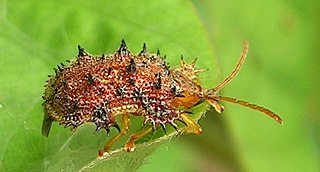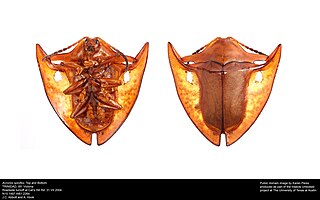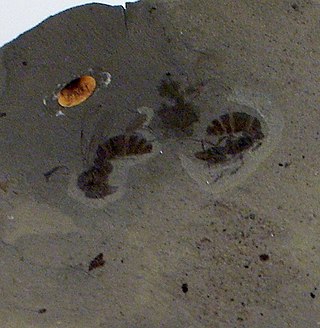
The Stephanidae, sometimes called crown wasps, are a family of parasitoid wasps. They are the only living members of the superfamily Stephanoidea. Stephanidae has at least 345 living species in 11 genera. The family is considered cosmopolitan in distribution, with the highest species concentrations in subtropical and moderate climate zones. Stephanidae also contain four extinct genera described from both compression fossils and inclusions in amber.

The Cassidinae are a subfamily of the leaf beetles, or Chrysomelidae. The antennae arise close to each other and some members have the pronotal and elytral edges extended to the side and covering the legs so as to give them the common name of tortoise beetles. Some members, such as in the tribe Hispini, are notable for the spiny outgrowths to the pronotum and elytra.
Fibla carpenteri is an extinct species of snakefly in the Inocelliidae genus Fibla. F. carpenteri is named in honor of the paleoentomologist Dr Frank Carpenter, for his vast knowledge and interest in Raphidioptera.

Florissantoraphidia is an extinct genus of snakefly in the family Raphidiidae containing two described species Florissantoraphidia funerata and Florissantoraphidia mortua. Both species were originally placed in the living raphidiid genus Raphidia, as Raphidia funerata and Raphidia mortua respectively. before being redescribed and transferred to the newly erected genus in 2014.

Archiinocellia is an extinct genus of snakefly in the family Raphidiidae known from Eocene fossils found in western North America. The genus contains two species, the older Archiinocellia oligoneura and the younger Archiinocellia protomaculata. The type species is of Ypresian age and from the Horsefly Shales of British Columbia, while the younger species from the Lutetian Green River Formation in Colorado. Archiinocellia protomaculata was first described as Agulla protomaculata, and later moved to Archiinocellia.

Prodryas persephone is an extinct species of brush-footed butterfly, known from a single specimen from the Chadronian-aged Florissant Shale Lagerstätte of Late Eocene Colorado. P. persephone is the first fossil butterfly to be found in North America, and is exquisitely well preserved. Its closest extant relatives are the mapwings and African admirals of the genera Hypanartia and Antanartia, respectively.

Acromis spinifex is a species of tortoise beetle from South America. The males have enlarged elytra which are probably used in male–male combat, while females are among the few tortoise beetles to show maternal care of their offspring.

Ypresiomyrma is an extinct genus of ants in the subfamily Myrmeciinae that was described in 2006. There are four species described; one species is from the Isle of Fur in Denmark, two are from the McAbee Fossil Beds in British Columbia, Canada, and the fourth from the Bol’shaya Svetlovodnaya fossil site in Russia. The queens of this genus are large, the mandibles are elongated and the eyes are well developed; a stinger is also present. The behaviour of these ants would have been similar to that of extant Myrmeciinae ants, such as solitary foraging for arthropod prey and never leaving pheromone trails. The alates were poor flyers due to their size, and birds and animals most likely preyed on these ants. Ypresiomyrma is not assigned to any tribe, and is instead generally regarded as incertae sedis within Myrmeciinae. However, some authors believe Ypresiomyrma should be assigned as incertae sedis within Formicidae.

Denaeaspis is an extinct genus of tortoise beetle in the family Chrysomelidae and containing a single species Denaeaspis chelonopsis. The species is known only from the Middle Eocene Parachute Member, part of the Green River Formation, in the Piceance Creek Basin, Garfield County, northwestern Colorado, USA.
Emiliana is an extinct genus of planthopper in the Tropiduchidae tribe Emilianini and containing the single species Emiliana alexandri. The species is known only from the Middle Eocene Parachute Member, part of the Green River Formation, in the Piceance Creek Basin, Garfield County, northwestern Colorado, USA.
Halictus? savenyei is an extinct species of sweat bee possibly in the halictid genus Halictus. The species is solely known from the Early Eocene, Ypresian stage, Coldwater Beds, part of the Princeton Group, in the Quilchena area, Nicola Country, British Columbia, Canada.
Uintascorpio is an extinct genus of scorpion in the family Buthidae and containing the single species Uintascorpio halandrasorum. The species is known only from the Middle Eocene Parachute Member, part of the Green River Formation, in the Piceance Creek Basin, Garfield County, northwestern Colorado, USA.

Diochus electrus is an extinct species of rove beetle in genus Diochus, the only definitive fossil species in subfamily Staphylininae. The species is known only from the middle Eocene, Lutetian stage Baltic amber found in the Blaue Erde deposits, Baltic region, Northern Europe.

Haidoterminus is an extinct genus of ant in the Formicidae subfamily Haidomyrmecinae, and is one of only nine genera placed in this subfamily. The genus contains a single described species Haidoterminus cippus and is known from one Late Cretaceous fossil which has been found in North America.

Archimyrmex is an extinct genus of ant in the formicid subfamily Myrmeciinae, described by palaeoentomologist Theodore Cockerell in 1923. The genus contains four described species, Archimyrmex rostratus, Archimyrmex piatnitzkyi, Archimyrmex smekali and Archimyrmex wedmannae. Archimyrmex is known from a group of Middle Eocene fossils which were found in North America, South America, and Europe. The genus was initially placed in the subfamily Ponerinae, but it was later placed in Myrmeciinae; it is now believed to be the ancestor of the extant primitive genus Myrmecia from Australia. Despite this, Archimyrmex is not a member to any tribe and is regarded as incertae sedis within Myrmeciinae. However, some authors believe Archimyrmex should be assigned as incertae sedis within Formicidae. These ants can be characterised by their large mandibles and body length, ranging from 13.2 to 30 mm. They also have long, thin legs and an elongated mesosoma (thorax) and petiole.
Eoprephasma is an extinct genus of stick insect in the susumaniid subfamily Susumaniinae known from a group of Eocene fossils found in North America. When first described there was a single named species, Eoprephasma hichensi.
This list of fossil arthropods described in 2009 is a list of new taxa of trilobites, fossil insects, crustaceans, arachnids and other fossil arthropods that have been described during the year 2009, as well as other significant discoveries and events related to arthropod paleontology that occurred.

Euglossopteryx is an extinct genus of bee in the family Apidae known from a fossil found in North America. There is one described species in the genus, Euglossopteryx biesmeijeri.

Gyaclavator is an extinct genus of lace bug in the family Tingidae known from a fossil found in North America. The genus contains a single species, Gyaclavator kohlsi.
The Green River Formation is a geological formation located in the Intermountain West of the United States, in the states of Colorado, Utah, and Wyoming. It comprises sediments deposited during the Early Eocene in a series of large freshwater lakes: Lake Gosiute, Lake Uinta, and Fossil Lake. It preserves a high diversity of freshwater fish, birds, reptiles, and mammals, with some sections of the formation qualifying as Konservat-Lagerstätten due to their extremely well-preserved fossils.













